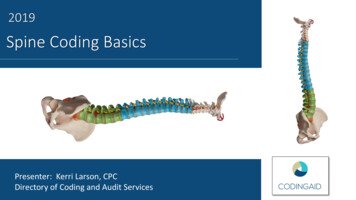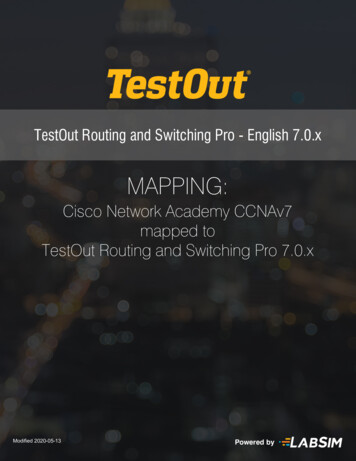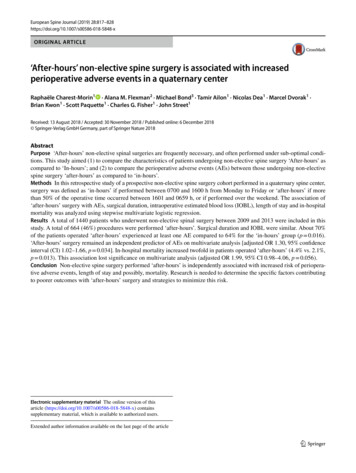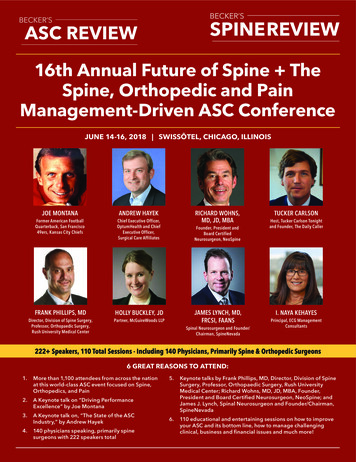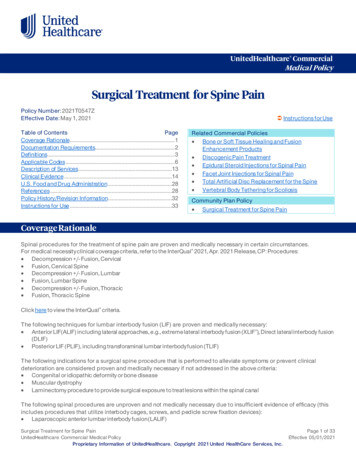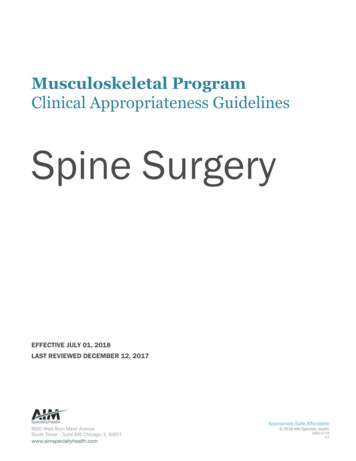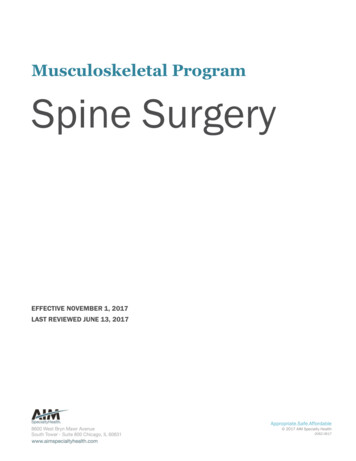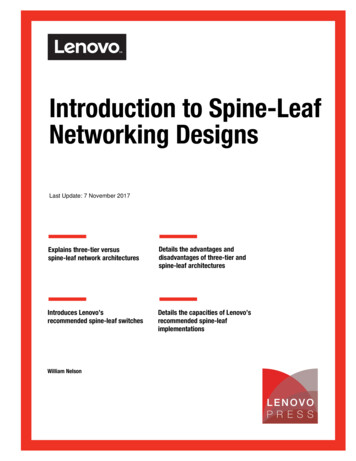
Transcription
Front coverIntroduction to Spine-LeafNetworking DesignsLast Update: 7 November 2017Explains three-tier versusspine-leaf network architecturesDetails the advantages anddisadvantages of three-tier andspine-leaf architecturesIntroduces Lenovo’srecommended spine-leaf switchesDetails the capacities of Lenovo’srecommended spine-leafimplementationsWilliam NelsonClick here to check for updates
AbstractThe traditional three-layer network topologies are losing momentum in the modern datacenter and are being supplanted by spine-leaf designs (also known as Clos designs after oneof the original researchers, Charles Clos). This is even despite three-layer familiarity,scalability and ease of implementation.Why is this happening? Organizations are seeking to maximize the function and utilization oftheir data centers leading to architecture optimized for software defined and cloud solutions.The spine-leaf architecture provides a strong base for the software defined data centeroptimizing the reliability and bandwidth available server communications.This document describes the following: The traditional three-layer and spine-leaf architectures The advantages and disadvantages of each architecture approach Lenovo ’s spine-leaf solutionsThis paper is for network architects and decision makers desiring to understand whyspine-leaf designs are important to the modern data center and how Lenovo Networkingproducts can be utilized in these designs.At Lenovo Press, we bring together experts to produce technical publications around topics ofimportance to you, providing information and best practices for using Lenovo products andsolutions to solve IT challenges.See a list of our most recent publications at the Lenovo Press web site:http://lenovopress.comDo you have the latest version? We update our papers from time to time, so checkwhether you have the latest version of this document by clicking the Check for Updatesbutton on the front page of the PDF. Pressing this button will take you to a web page thatwill tell you if you are reading the latest version of the document and give you a link to thelatest if needed. While you’re there, you can also sign up to get notified via email wheneverwe make an update.ContentsApproaches for Network Designs. . . . . . . . . . . . . . . . . . . . . . . . . . . . . . . . . . . . . . . . . . . . . . 3Lenovo spine-leaf . . . . . . . . . . . . . . . . . . . . . . . . . . . . . . . . . . . . . . . . . . . . . . . . . . . . . . . . . . 6Conclusion . . . . . . . . . . . . . . . . . . . . . . . . . . . . . . . . . . . . . . . . . . . . . . . . . . . . . . . . . . . . . . 21Appendix: Lenovo spine-leaf capacities . . . . . . . . . . . . . . . . . . . . . . . . . . . . . . . . . . . . . . . . 22Acronyms . . . . . . . . . . . . . . . . . . . . . . . . . . . . . . . . . . . . . . . . . . . . . . . . . . . . . . . . . . . . . . . 23Change history . . . . . . . . . . . . . . . . . . . . . . . . . . . . . . . . . . . . . . . . . . . . . . . . . . . . . . . . . . . 23Author. . . . . . . . . . . . . . . . . . . . . . . . . . . . . . . . . . . . . . . . . . . . . . . . . . . . . . . . . . . . . . . . . . 23Notices . . . . . . . . . . . . . . . . . . . . . . . . . . . . . . . . . . . . . . . . . . . . . . . . . . . . . . . . . . . . . . . . . 24Trademarks . . . . . . . . . . . . . . . . . . . . . . . . . . . . . . . . . . . . . . . . . . . . . . . . . . . . . . . . . . . . . 252Introduction to Spine-Leaf Networking Designs
Approaches for Network DesignsThe overall network performance is highly dependent upon the design approach that isutilized. These approaches can be optimized for either north-south or east-west traffic flows.The following three-tier and spine-leaf architectures are two classic approaches utilized tooptimize designs for north-south and east-west traffic respectively.Three-tier architectureData center technologies are driving network architecture changes from the traditionalthree-tier architecture, as shown in Figure 1.CoreRouterRouter(L3)(L3)Layer 3AggregationLayer 2Routing Switch Routing SwitchRouting Switch Routing SwitchRouting Switch Routing itch 1Switch nSwitch 1Switch nSwitch 1Switch n(L2)(L2)(L2)(L2)Access(L2)Pod 1Pod 2(L2)Pod nFigure 1 Traditional three-tier architectureThis architecture consists of three major layers:1. Core – Layer 3 (L3) routers providing separation of the pods2. Aggregation – Layer 2/3 (L2/3) switches which serve as boundaries between the pods.3. Access – Layer 2 (L2) switches providing loop free pod designs utilizing either spanningtree protocol or virtual link aggregation (VLAG) as displayed in Figure 1.The three-tier architecture has served the data center well for many years providing effectiveaccess to servers within the pod and isolation between the pods. This matches very cleanlywith traditional server functions which require east-west traffic within the pod but limitedNorth/South traffic across pods thru the core network. The difficulty that arises with thisarchitecture is an increased latency for pod-to-pod (east-west) traffic.Advantages of the three-tier architectureThe three-tier architecture has been in existence for many years and displacing this for otherapproaches should not be taken lightly since it is well known and proven. This architecturehas distinct benefits including: Copyright Lenovo 2017. All rights reserved.3
Availability – if a pod is down due to equipment or some other failure, it can be easilyisolated to a branch (pod) without affecting other branches (pods) Security – processes and data can be isolated in pods limiting exposure risks Performance – traffic within the pod is reduced so oversubscription is minimized Scalability – if a pod becomes oversubscribed, it is a simple task to add another pod andload-balance traffic across them and improving application performance Simplicity –network issues caused by leaf devices are simplified because the number ofdevices in each branch are limitedDisadvantages of the three-tier architectureAs previously stated, software defined infrastructures are requiring changes in the traditionalnetwork architecture demanding expanded east-west traffic flows. The major softwaredefined applications driving this are virtualization and convergence. Virtualization requires moving workloads across multiple devices which share commonbackend information. Convergence requires storage traffic between devices on the same network segment.These applications also drive increased bandwidth utilization which is difficult to expandacross the multiple layered network devices in the three-tier architecture. This leads to thecore network devices being very expensive high speed links.Spine-leaf architectureNew data centers are now being designed for cloud architectures with larger east-west trafficdomains. This drives the need for a network architectures with an expanded flat east-westdomain like spine-leaf as shown in Figure 2 on page 5. Solutions like VMware NSX,OpenStack and others that distribute workloads to virtual machines running on many overlaynetworks running on top of a traditional underlay (physical) network require mobility acrossthe flatter east-west domain.4Introduction to Spine-Leaf Networking Designs
CoreRouterRouter(L3)(L3)SpineLeafFigure 2 Spine-leaf ArchitectureThe spine-leaf architecture is also known as a Clos architecture (named after Charles Clos, aresearcher at Bell Laboratories in the 1950s) where every leaf switch is connected to each ofthe spine switch in a full-mesh topology. The spine-leaf mesh can be implemented usingeither Layer 2 or 3 technologies depending on the capabilities available in the networkingswitches.Layer 3 spine-leafs require that each link is routed and is normally implemented using OpenShortest Path First (OSPF) or Border Gateway Protocol (BGP) dynamic routing with equalcost multi-path routing (ECMP). Layer 2 utilizes a loop-free Ethernet fabric technology suchas Transparent Interconnection of Lots of Links (TRILL) or Shortest Path Bridging (SPB).The core network is also connected to the spine with Layer 3 using a dynamic routingprotocol with ECMP. Redundant connections to each spine switch are not required but highlyrecommended, as show in Figure 2. This minimizes the risk of overloading the links on thespine-leaf fabric.This architecture provides a connection thru the spine with a single hop between leafsminimizing any latency and bottle necks. The spine can be expanded or decreaseddepending on the data thru-put required.Advantages of the spine-leaf architectureThe spine-leaf architecture is optimized for east-west traffic that is required by most softwaredefined solutions. The advantages of this approach are: All interconnections are used and there is no need for STP to block loops All east-west traffic is equidistant so traffic flow has deterministic latency Switch configuration is fixed so that no network changes are required for a dynamic serverenvironment5
Disadvantages of the spine-leaf architectureThe spine-leaf architecture is not without concerns as listed below: The leading concern is the amount of cables and network equipment required to scale thebandwidth since each leaf must be connected to every spine device. This can lead tomore expensive spine switches with high port counts. The number of hosts that can be supported can be limited due to spine port countsrestricting the number of leaf switch connections. Oversubscription of the spine-leaf connections can occur due to a limited number of spineconnections available on the leaf switches (typically 4 to 6). Generally, no more than a 5:1oversubscription ratio between the leaf and spine is considered acceptable but this ishighly dependent upon the amount of traffic in your particular environment. Oversubscription of the links out of the spine-leaf domain to the core should also beconsidered. Since this architecture is optimized for east-west traffic as opposed tonorth-south, oversubscriptions of 100:1 may be considered acceptable.Lenovo spine-leafThe spine-leaf architecture provides a loop free mesh between the spine and the leafswitches. This can be accomplished using either Layer 2 or 3 designs. Lenovo providessolutions for small two switch Layer 2 spines and expanded multi-switch Layer 3 spinesutilizing either Cloud Network Operating System (CNOS) or Enterprise Network OperatingSystem (ENOS).The following sections detail Lenovo’s recommendation for spine-leaf switches, and Layer 2and 3 designs.A table summarizing the scaling of Lenovo's spine-leaf solutions is also provided in“Appendix: Lenovo spine-leaf capacities” on page 22 as a convenient reference.Lenovo Layer 2 spine-leaf architectureLenovo implements the Layer 2 spine-leaf network utilizing VLAG to provide a non-blockingloop free design as show in Figure 3 on page 7. Every spine-leaf switch is aggregated in pairsof switches utilizing 100 Gbps spine links providing a 400 Gbps spine with very lowcongestion. This solution offers the ability to connect to redundant server NICs using bondingwith LAG or MAC address load balancing as well as utilizing the NICs independently.6Introduction to Spine-Leaf Networking Designs
CoreRouterRouter(L3)(L3)Core connection is possibleusing L2 with a VLAG or routingusing VRRP and ECMPNE10032SpineEach leaf pair has a 400Gbps VLAG to the spine witha connection to each spineswitch from each leaf switchin the pair.NE2572 Switch 1NE2572 Switch 2NE2572 Switch 27NE2572 Switch 28NE2572LeafFour (4) 100 Gbps links from each leaf switch are utilized for an ISL (2 links) and uplink to the spine (2 links).Figure 3 Lenovo Layer 2 spine-leaf architecture with VLAG at the spine-leafAn alternate Layer 2 design shown in Figure 4 utilizes VLAG only in the spine with a LAG inthe leaf switches connecting back to the spine. This solution provides a 200 Gbps spine withslightly higher congestion while providing the ability to connect more servers. Server NICscan be connected as individual NICs or bonding with MAC address load balancing.CoreRouterRouter(L3)(L3)Core connection is possibleusing L2 with a VLAG or routingusing VRRP and ECMPNE10032SpineEach leaf switch has an 200Gbps VLAG to the spine witha connection to each spineswitch.NE2572 Switch 1NE2572 Switch 2NE2572 Switch 27NE2572 Switch 28NE2572LeafEach leaf switch has two (2) 100 Gbps links in a LAG to the spine.Figure 4 Lenovo Layer 2 spine-leaf architecture with VLAG at the spine onlyBoth Layer 2 implementation can connect to the core using Layer 3 with ECMP and VRRPactive-active or with VLAG for a full Layer 2 spine implementation.7
Lenovo Layer 3 spine-leaf ArchitectureFigure 5 is an example of Lenovo’s Layer 3 spine-leaf Architecture which utilizes a dynamicrouting protocol such as BGP or OSPF to provide connection between all of the spine-leafswitches and core network. While Layer 3 has more complex configurations than Layer 2, itprovides a more scalable spine with speeds ranging from 200 to 600 Gbps depending on thetype of leaf switch utilized and the number of ThinkSystem NE10032 spine switches.Layer 3 spine/leaf designs have become more common because L3 (routed) ports havedropped in cost to where they are no more costly than a L2 (switched) port. This is true of theLenovo switches shown in Figure 5.Future CNOS firmware releases will provide enhanced capabilities to implement virtualizedoverlay networks using VXLAN and providing redundant Virtual Tunnel End-Points (VTEPs)for virtualization environments.CoreRouterRouter(L3)(L3)2 x 10/25/40/100 Gbps L3interfaces from each spineswitch to core using VRRPand ECMPNE10032 Spine Switch 1Up to 6 x NE10032 Spine SwitchesNE10032 Spine Switch nNE10032SpineEach leaf switch has an 100Gbps link to each spineswitch.NE2572 Switch 1NE2572 Switch 2NE2572 Switch 29NE2572 Switch 30NE2572LeafEach leaf switch has a 100 Gbps L3-only link utilizing ECMP with BGP orOSPF yielding up to 600 Gbps access to the spine.Figure 5 Lenovo Layer 3 spine-leaf architecture using dynamic routingLenovo spine switchesThe spine switch is used to connect the leaf switches. Lenovo has two recommended leafswitches each with the same number of ports but with different uplink speeds.When considering the spine switch consider the following aspects: Number of leaf switches to be connected Types uplink connections (100/40 Gbps QSFP28 vs 40 Gbps QSFP )The switch with the least number of 100 or 40 Gigabit ports will limit the cumulative spinespeed.8Introduction to Spine-Leaf Networking Designs
Lenovo ThinkSystem NE10032 RackSwitch Spine SwitchThe Lenovo ThinkSystem NE10032 RackSwitch (Figure 6) is Lenovo’s preferred spineswitch which offers 100 Gbps or 40 Gbps Ethernet spine connections.The NE10032 has the following features that are important for this spine switch: Layer 2/3 for both routing and switching32 QSFP28 ports for high speed 100 or 40 Gbps Ethernet connectionsCNOS for enhanced BGP, OSPF and ECMP routingVLAG for Layer 2 fabricSingle chip design for improved latency and buffer managementFigure 6 Lenovo ThinkSystem NE10032 RackSwitch Spine SwitchThe NE10032 can connect up to: 28 leaf switches with a L2 implementation with two spine switches and a 200 Gigabit spinewithout leaf switch VLAG or 14 leaf switches with a 400 Gbps spine with leaf switch VLAG 30 leaf switches with a L3 implementation and a scalable spine up to 600 Gigabit (6switch) spineLenovo RackSwitch G8332 Spine SwitchThe Lenovo RackSwitch G8332 (Figure 7) is a 40 Gbps Ethernet spine switch. The G8332has the following features that are important for this spine switch: Layer 2/3 for both routing and switching32 QSFP ports for high speed 40 Gbps Ethernet connectionsCNOS for enhanced BGP, OSPF and ECMP routingVLAG for Layer 2 fabricSingle chip design for improved latency and buffer managementFigure 7 Lenovo RackSwitch G8332 Spine SwitchThe G8332 can connect up to: 28 leaf switches with a L2 implementation with two spine switches and an 80 Gigabit spinewithout leaf switch VLAG or 14 leaf switches with a 160 Gbps spine with leaf switch VLAG 30 leaf switches with a L3 implementation and a scalable spine up to 400 Gigabit (10switch) spineLenovo leaf switchesThe leaf switch is used to connect server nodes. Lenovo has three recommended leafswitches each with varying number of ports and types of connections: Number of ports for connecting to servers Types of server NIC connections Number of 100 or 40 Gbps ports for connecting to the spine9
When considering mixed types of leaf switches, the switch with the least number of 100 or 40Gigabit ports will limit the cumulative spine speed.Leaf switches described in this section: “Lenovo ThinkSystem NE2572 RackSwitch Leaf Switch”“Lenovo RackSwitch G8272 Leaf Switch” on page 12“Lenovo RackSwitch G8296 Leaf Switch” on page 15“Lenovo EN4093R Leaf Switch for Flex System” on page 18Lenovo ThinkSystem NE2572 RackSwitch Leaf SwitchThe Lenovo ThinkSystem NE2572 RackSwitch (Figure 8) is Lenovo’s preferred leaf switchwhich offers 100 Gbps or 40 Gbps Ethernet spine connections and 25 or 10 Gbps serverconnections.The NE2572 has the following features that are important for this leaf switch: Layer 2/3 for both routing and switching48 SFP28 ports for 25 or 10 Gbps Ethernet connections to servers6 QSFP28 ports for high speed 100 or 40 Gbps Ethernet connections to the spineCNOS for enhanced BGP, OSPF and ECMP routingVLAG for Layer 2 fabricSingle chip design for improved latency and buffer managementFigure 8 Lenovo ThinkSystem NE2572 RackSwitch Leaf SwitchSolutions utilizing the NE2572 are characterized as follows: Layer 2 solution with VLAG with 28 leaf switches connected to a 400 (2 switch spine)Gbps spine can connect up to 1,568 (28 x (48 8)) server ports with an oversubscription of4:1 ((25Gx56 servers):400G); if only 25G SFP28 ports are used the oversubscription is3:1 (25Gx48 servers:400G). This solution is shown in Figure 9.10Introduction to Spine-Leaf Networking Designs
CoreRouterRouter(L3)(L3)2 x 100/40/25/10 Gbps L3interfaces from each spineswitch to core using VRRPand ECMPNE10032SpineEach leaf pair has a 400Gbps VLAG to the spine witha connection to each spineswitch from each leaf switchin the pair.NE2572 Switch 1NE2572 Switch 2NE2572 Switch 27NE2572 Switch 28NE2572LeafFour (4) 100 Gbps links from each leaf switch are utilized for an ISL (2 links) and uplink to the spine (2 links).Figure 9 ThinkSystem NE2572 RackSwitch Layer 2 solution with VLAG Layer 2 solution with no leaf VLAG with 28 leaf switches connected to an 80 Gbps spinecan up to 1,792 (28 x (48 16)) server ports with an oversubscription of 8:1 ((25Gx64servers):200G); if only 25G SFP28 ports are used the oversubscription is 6:1 ((25Gx48servers):200G); at a cost to some redundancy and connections options to the server. Thissolution is shown in Figure 10.CoreRouterRouter(L3)(L3)2 x 100/40/25/10 Gbps L3interfaces from each spineswitch to core using VRRPand ECMPNE10032SpineEach leaf switch has an 200Gbps VLAG to the spine witha connection to each spineswitch.NE2572 Switch 1NE2572 Switch 2NE2572 Switch 27NE2572 Switch 28NE2572LeafEach leaf switch has two (2) 100 Gbps links in a LAG to the spine.Figure 10 ThinkSystem NE2572 RackSwitch Layer 2 solution with no leaf VLAG11
Layer 3 solution with 30 leaf switches – The Layer 3 solutions are all based off of thefollowing architecture diagram and only vary by then number of spine switches that areconnected or reserved ports. This solution is shown in Figure 11 on page 12.CoreRouterRouter(L3)(L3)Spine Switch 12 x 100/40/25/10 Gbps L3interfaces from each spineswitch to core using VRRPand ECMPSpine Switch nUp to 6 x Spine SwitchesNE10032SpineEach leaf switch has an 100Gbps link to each spineswitch.NE2572 Switch 1NE2572 Switch 2NE2572 Switch 29NE2572 Switch 30NE2572LeafThere are up to 30 x NE2572 leaf switches in this solution, the availableserver connections are dependent upon the number of spine switches.Figure 11 ThinkSystem NE2572 RackSwitch Layer 3 solution with 30 leaf switchesTable 1 lists the capacities of Lenovo's Layer 3 solution using NE2572 leaf switches.Table 1 Lenovo ThinkSystem NE2572 RackSwitch L3 leaf switch capacitiesServer portsper leaf switchSpine switchquantitySpine speed(Gbps)Leaf ounded 3019208:18:1Lenovo RackSwitch G8272 Leaf SwitchThe Lenovo RackSwitch G8272 is Lenovo’s 1U 10 Gbps Ethernet solution for the leaf switch.The G8272 has the following features that are important for this leaf switch: Layer 2/3 for both routing and switching CNOS for enhanced BGP, OSPF and ECMP routing VLAG for Layer 2 fabric Single chip design for improved latency and buffer management12Introduction to Spine-Leaf Networking Designs
6 QSFP ports for 40 Gbps spine connections allowing for a maximum cumulative spinespeed of 240 Gbps. The QSFP ports not utilized for spine connections can be broken outinto 4 x 10 Gigabit Ethernet ports for additional server connections. 48 SFP ports for 1/10 Gigabit Ethernet server connections per leaf switchThe Lenovo RackSwitch G8272 is shown in Figure 12.Figure 12 Lenovo RackSwitch G8272 Leaf SwitchSolutions utilizing the G8272 are characterized as follows: Layer 2 solution with VLAG with 28 leaf switches connected to a 160 (2 switch spine)Gbps spine can connect up to 1,568 (28 x (48 8)) server ports with an oversubscription of4:1 ((10Gx56 servers):160G); if only 10G SFP ports are used the oversubscription is 3:1(10Gx48 servers:160G). This solution is shown in Figure 13 on page 13.CoreRouterRouter(L3)(L3)2 x 10/40 Gbps L3 interfacesfrom each spine switch tocore using VRRP and ECMPNE10032or G8332SpineEach leaf pair has a 160Gbps VLAG to the spine witha connection to each spineswitch from each leaf switchin the pair.G8272 Switch 1G8272 Switch 2G8272 Switch 27G8272 Switch 28G8272LeafFour (4) 40 Gbps links from each leaf switch are utilized for an ISL (2 links) and uplink to the spine (2 links).Figure 13 RackSwitch G8272 Layer 2 solution with VLAG Layer 2 solution with no leaf VLAG with 28 leaf switches connected to an 80 Gbps spinecan up to 1,792 (28 x (48 16)) server ports with an oversubscription of 8:1 ((10Gx64servers):80G); if only 10G SFP ports are used the oversubscription is 6:1 ((10Gx48servers):80G); at a cost to some redundancy and connections options to the server. Thissolution is shown in Figure 14.13
CoreRouterRouter(L3)(L3)2 x 10/40 Gbps L3 interfacesfrom each spine switch tocore using VRRP and ECMPNE10032or G8332SpineEach leaf switch has an 80Gbps VLAG to the spine witha connection to each spineswitch.G8272 Switch 1G8272 Switch 2G8272 Switch 27G8272 Switch 28G8272LeafEach leaf switch has two (2) 40 Gbps links in a LAG to the spine.Figure 14 RackSwitch G8272 Layer 2 solution with no leaf VLAG Layer 3 solution with 30 leaf switches – The Layer 3 solutions are all based off of thefollowing architecture diagram and only vary by then number of spine switches that areconnected or reserved ports. This solution is shown in Figure 15.CoreRouterRouter(L3)(L3)2 x 10/40 Gbps L3 interfacesfrom each spine switch tocore using VRRP and ECMPSpine Switch 1Up to 6 x Spine SwitchesSpine Switch nNE10032or G8332SpineEach leaf switch has an 40Gbps link to each spineswitch.G8272 Switch 1G8272 Switch 2G8272 Switch 29G8272 Switch 30G8272LeafThere are up to 30 x G8272 leaf switches in this solution, the availableserver connections are dependent upon the number of spine switches.Figure 15 RackSwitch G8272 Layer 3 solution with 30 leaf switchesTable 2 lists the capacities of Lenovo's Layer 3 solution utilizing G8272 leaf switches.14Introduction to Spine-Leaf Networking Designs
Table 2 Lenovo RackSwitch G8272 leaf switch capacitiesServer portsper leaf switchSpine switchquantitySpine speed(Gbps)Leaf ounded 019208:18:1Lenovo RackSwitch G8296 Leaf SwitchThe Lenovo RackSwitch G8296 is Lenovo’s 2U solution for the leaf switch. The G8296 hasthe following features that are important for this leaf switch: Layer 2/3 for both routing and switching CNOS for enhanced BGP, OSPF and ECMP routing VLAG for Layer 2 fabric Single chip design for improved latency and buffer management 10 QSFP ports for 40 Gbps spine connections allowing for a maximum cumulative spinespeed of 400 Gbps. Two of the QSFP ports not utilized for spine connections can bebroken out into 4 x 10 Gigabit Ethernet ports for eight additional server connections. Theremaining QSFP ports can be utilized as a single server connection. 86 SFP ports for 1/10 Gigabit Ethernet server connections per leaf switchThe Lenovo RackSwitch G8296 is shown in Figure 16.Figure 16 Lenovo RackSwitch G8296 Leaf SwitchSolutions utilizing the G8296 are characterized as follows: Layer 2 solution with VLAG with 28 leaf switches connected to a 160 Gbps spine canconnect up to 2,744 (28 x (86 8 4)) server ports with an oversubscription of 6:1 ((10Gx98servers:160G). This solution is shown in Figure 17.15
CoreRouterRouter(L3)(L3)2 x 10/40 Gbps L3 interfacesfrom each spine switch tocore using VRRP and ECMPNE10032or G8332SpineEach leaf pair has a 160Gbps VLAG to the spine witha connection to each spineswitch from each leaf switchin the pair.G8296LeafG8296 Switch 1G8296 Switch 2G8296 Switch 27G8296 Switch 28Four (4) 40 Gbps links from each leaf switch are utilized for an ISL (2 links) and uplink to the spine (2 links).Figure 17 RackSwitch G8296 Layer 2 solution with VLAG (28 leaf switches) Layer 2 solution VLAG with 14 leaf switches connected to a 320 Gbps spine byaggregating two QSFP ports on each leaf switch can connect up to 1,316 (14 x (86 8))server ports with an oversubscription of 3:1 ((10Gx94 servers:320G). This solution, shownin Figure 18 on page 16, doubles the spine connections to reduce oversubscription but willalso reduce the maximum number of server conneciton possible for the solution.CoreRouterRouter(L3)(L3)2 x 10/40 Gbps L3 interfacesfrom each spine switch tocore using VRRP and ECMPNE10032or G8332SpineEach leaf pair has a 320 GbpsVLAG to the spine with aconnection to each spineswitch from each leaf switchin the pair.G8296LeafG8296 Switch 1G8296 Switch 2G8296 Switch 13G8296 Switch 14Four (8) 40 Gbps links from each leaf switch are utilized for an ISL (4 links) and uplink to the spine (4 links).Figure 18 RackSwitch G8296 Layer 2 solution with VLAG (14 leaf switches)16Introduction to Spine-Leaf Networking Designs
Layer 2 solution no leaf VLAG with 30 leaf switches connected to an 80 Gbps spine canup to 2,856 (28 x (86 8 8)) server ports with an oversubscription of 13:1 ((10Gx102servers:80G) at a cost to redundancy. This solution is shown in Figure 19.CoreRouterRouter(L3)(L3)2 x 10/40 Gbps L3 interfacesfrom each spine switch tocore using VRRP and ECMPNE10032or G8332SpineEach leaf switch has an 80Gbps VLAG to the spine witha connection to each spineswitch.G8296LeafG8296 Switch 1G8296 Switch 2G8296 Switch 27G8296 Switch 28Each leaf switch has two (2) 40 Gbps links in a LAG to the spine.Figure 19 RackSwitch G8296 Layer 2 solution no leaf VLAG Layer 3 solution with 30 leaf switches – The Layer 3 solutions are all based off of thefollowing architecture diagram and only vary by then number of spine switches that areconnected or reserved ports. The G8296 supports up to 10 spine switches. This solution isshown in Figure 20.17
CoreRouterRouter(L3)(L3)2 x 10/40 Gbps L3 interfacesfrom each spine switch tocore using VRRP and ECMPSpine Switch 1NE10032or G8332Spine Switch nSpineUp to 10 x Spine SwitchesEach leaf switch has an 40Gbps link to each spineswitch.G8296LeafG8296 Switch 1G8296 Switch 2G8296 Switch 27G8296 Switch 28There are up to 30 x G8296 leaf switches in this solution, the availableserver connections are dependent upon the number of spine switches.Figure 20 RackSwitch G8296 Layer 3 solutionTable 3 lists the capacities of Lenovo's layer 3 solution utilizing G8296 leaf switches.Table 3 Lenovo RackSwitch G8296 leaf switch capacitiesServer portsper leaf switchSpine switchquantitySpine speed(Gbps)Leaf ounded vo EN4093R Leaf Switch for Flex SystemThe Lenovo Flex System Fabric EN4093R 10Gb Scalable Switch is Lenovo’s Flex Systemsolution for the leaf switch. The EN4093R has the following features that are important for thisleaf switch: Layer 2/3 for both routing and switching18Introduction to Spine-Leaf Networking Designs
ENOS with BGP, OSPF and ECMP routing VLAG for Layer 2 fabric Single chip design for improved latency and buffer management 2 QSFP ports for 40 Gbps spine connections allowing for a maximum cumulative spinespeed of 80 Gbps. 14 dedicated server facing ports 14 SFP ports for 1/10 Gigabit external Ethernet server connections and an Inter-SwitchLink (ISL) for use with VLAGThe Lenovo Flex System Fabric EN4093R 10Gb Scalable Switch is shown in Figure 21.Figure 21 Lenovo Flex System Fabric EN4093R 10Gb Scalable SwitchSolutions utilizing the Flex System Chassis and the EN4093R have some limitations ascompared to TOR based solutions. The main limitation is the limited number of 40 Gbps portsrestricting this solution to two spine switches. There is also a limited number of servers thatcan be connected due to the hard wired connections to the Flex System server nodes.Solutions utilizing the EN4093R are characterized as follows: Layer 2 solution with VLAG with 28 leaf switches connected to a 160 (2 switch spine)Gbp
button on the front page of the PDF. Pressing this button will take you to a web page that . domain like spine-leaf as shown in Figure 2 on page 5. Solutions like VMware NSX, . NE2572 Switch 1 NE2572 Switch 2 NE2572 Switch 27 NE2572 Switch 28. 8 Introduction to Spine-Leaf Networking Design


